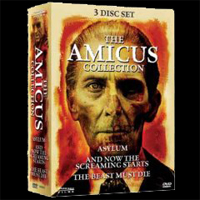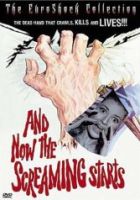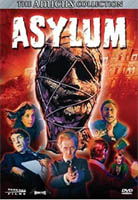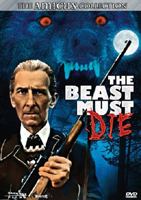
 BUY IT FROM AMAZON: CLICK HERE!
BUY IT FROM AMAZON: CLICK HERE!
STUDIO: Dark Sky Films
MSRP: $29.98
RATED: NR
RUNNING TIME: 270 minutes
SPECIAL FEATURES:
• Noted below
The Pitch
In July 2006, Dark Sky Films released three films from Amicus Productions. Now they’ve gathered them into one convenient package. The films include And Now the Screaming Starts! (David’s review), Asylum (Wade’s review), and The Beast Must Die (Ian’s review).
 AND NOW THE SCREAMING STARTS!
AND NOW THE SCREAMING STARTS!
RUNNING TIME: 90 minutes
SPECIAL FEATURES:
• Commentary with director Paul Annett
• “Directing The Beast!” featurette
• Cast & Crew Biographies
• Theatrical Trailers
• Still Gallery
The Humans
Peter Cushing, Stephanie Beacham, Ian Ogilvy, Herbert Lom, and Patrick Magee.
The Nutshell
Soon after arriving at the family estate of her new husband Charles (Ogilvy), Catherine (Beacham) Fengriffen is haunted by visions of an eyeless phantom, who bares a startling resemblance to the woodsman living on the estate, Silas. Charles enlists the aid of Dr. Whittle (Magee) to combat what he believes is Catherine’s insanity. Whittle and the servants believe a family curse is the culprit, not insanity. Eventually the reasonable and logical Dr. Pope (Cushing) is brought in to figure things out once and for all.
The Lowdown
Well, what do we have here? You could call it Mario Bava’s Rebecca, though it comes nowhere near the levels of excellence on display in Hitchcock’s film or anything by the Italian maestro. But it does an apt job of describing the atmosphere and basic storyline, so I’ll stick with it.
The fluid camerawork of director Roy Ward Baker and cinematographer Denys Coop is the highlight of the film. The camera weaves its way through Fengriffen manor, keeping things lively, which helps in the sections where the plot sags a bit or gets a little samey. There’s a stretch when a few of characters decide they’re going to fill Catherine in on the big secret, but meet their untimely end before spilling the beans. Baker stages the demises well and the use of the disembodied hand as the harbinger of doom brought me some joy. When one of the characters decides to help Catherine, I immediately started to look for the hand. It would appear without fail and I was satisfied, a simple pleasure for a simple mind.

"Damn. I am a bad ass."
Peter Cushing makes his first appearance about halfway through the film, but Ogilvy and Beacham do a fine job carrying things until he arrives. Speaking of Beacham, I believe it’s an unwritten rule that you must mention that she has a solid scream and a stupendous bosom in any review of And Now The Screaming Starts!, so I wanted to be sure to get that in. Herbert Lom stops by for a day’s work and is an excellently despicable bastard as Henry Fengriffen.
By the time all the secrets are revealed, you’ll probably have figured it out well in advance, but Baker and his cast make the journey plenty enjoyable.
 ASYLUM
ASYLUM
RUNNING TIME: 89 minutes
SPECIAL FEATURES:
• Commentary with director Roy Ward Baker & cameraman Neil Binney
• “Inside the Fear Factory” featurette
• Cast & Crew Biographies
• Theatrical Trailers
• Still Gallery
The Humans
Peter Cushing, Herbert Lom, Patrick Magee, Britt Ekland, Charlotte Rampling, Robert Powell, and Barry Morse.
The Nutshell
Dr. Martin (Powell) comes to Dunmoor Asylum expecting to be interviewed by the asylum’s director, Dr. Starr. Starr’s associate, Dr. Rutherford (Magee) explains how Starr suffered a breakdown and is now residing upstairs with the other patients. If Martin is able to deduce which patient is Starr, he will be given the position. His choices include Bonnie, whose affair with a married man left his wife in pieces; the tailor Bruno (Morse) who was commissioned by a strange man (Cushing) to build a suit to his exact specifications; Barbara (Rampling) who insists that her friend Lucy (Ekland) is the one who killed her brother and nurse; and Dr. Bryon (Lom) who is convinced he can bring mechanical dolls to life.
The Lowdown
Asylum is an anthology film. As such it has its high points and its low. None of the segments have the strong payoff that turns an okay short story into a great one, but Roy Ward Baker’s direction makes the affair worth watching.
The best of the bunch is the first segment, “Frozen Fear.” Baker uses the cluttered basement to its fullest, creating a palpable feeling of claustrophobia. Once Bonnie is down there, she has no place to go. The clutter also gives Baker plenty of opportunities for jump scares. Baker does a nice job balancing the use of mechanical limbs with those made of flesh and blood.

"Even my action figure is bad ass."
Baker’s excellent work continues into the next segment, “The Weird Tailor.” The story has the trappings of a classic piece of short horror (the mysterious stranger, a tinge of the occult, the naïve protagonist who’s in over his head), but instead of ending with a bang, it hardly manages a whimper. Baker maintains an atmosphere of uncertainty that fits the story like a glove, but it isn’t enough to save the ending.
The other two segments fail to match even the middling heights of “The Weird Tailor.” Though Herbert Lom bringing his miniature likeness to life using the power of his stare tickled me a bit. The business in the asylum that ties all the segments together is a pretty clever way to present an anthology, but, like “The Weird Tailor,” the ending does it a great disservice.  THE BEAST MUST DIE
THE BEAST MUST DIE
RUNNING TIME: 92 minutes
SPECIAL FEATURES:
• Commentary with director Roy Ward Baker & actor Stephanie Beckham
• Commentary with actor Ian Ogilvy
• Cast & Crew Biographies
• Theatrical Trailers
• Still Gallery
The Humans
Calvin Lockhart, Peter Cushing, Marlene Clark, Anton Diffring, Charles Gray, Ciaran Madden, Tom Chadbon, and Michael Gambon.
The Nutshell
Tom Newcliffe (Lockhart) invites a group of distinguished guests to his estate to enjoy their company. The group consists of Dr. Christopher Lundgren (Cushing), Paul Foote (Chadbon), Bennington (Gray), Jan Jarmokowski (Gambon), and Jan’s girlfriend Davina (Madden).
The Lowdown
The opening of the film had me hoping for some kind of racial riff on The Prisoner. As the visions of Patrick McGoohan in blackface diminished, I turned my attention to what I thought might be the highlight of The Beast Must Die: the “werewolf break.”
The “werewolf break” is a one-minute intermission that allows the audience time to guess the identity of the werewolf. The very existence of the “werewolf break” had me all atwitter. After the opening title card and narration told me that this was a detective story in which I was the detective, I put on my Sherlock Holmes hat and pulled out my magnifying glass, ready to scour the film in search of clues. As the film progressed, I slowly felt myself turning into a sucker, Looney Tunes style. A sucker holding a magnifying glass. In the film, the business of identifying the werewolf is completely perfunctory. The characters do things that are suspicious (not being where they’re supposed to, not entertaining Newcliffe’s whims), but no hard evidence ever materializes. Unless you count a bounty of body hair that may or may not have always been there. No real case is made against one character or another. The “werewolf break” proved to be nothing more than the producer’s gimmicky afterthought.

Everybody hated it when Leo got drunk and started to play indentured servant.
So I was burned by the “werewolf break,” was there anything in the film that could win me back? Not so much. The cast isn’t given much to do. They basically stand around trying to look guilty or not guilty. Calvin Lockhart does an admirable job carrying the film. Newcliffe’s obsession with the werewolf is believable and keeps thing moving. The surveillance employed by Newcliffe could have made for some interesting sequences of cat-and-mouse between the hunter and the hunted, but the werewolf destroys it before it can be used to its fullest. The Beast Must Die isn’t able to overcome the missed opportunities to provide any semblance of entertainment.
The Package
All three films look very good and the only problem with the sound was some dodgy looping in The Beast Must Die. Trailers for all three films can be found on each DVD, as can still galleries and biographies of the cast and crew.
Featurettes accompany Asylum and The Beast Must Die. “Inside the Fear Factory” is on the Asylum disc and is a brief overview of Amicus Productions. We get interviews with co-founder Max Rosenberg and directors Freddie Francis and Roy Ward Baker. The candor expressed by the interviewees is the highlight of the piece. Francis, one of the best cinematographers ever, expresses doubts as to whether or not he should have ever started directing. Rosenberg states how it’s “lovely to speak ill of the dead” before complaining about how he got the shaft in regards to the profits from The Curse of Frankenstein (a film that began as a script written by Rosenberg and Amicus cohort Milton Subotsky). “Directing ‘The Beast!’” appears on (surprise) The Beast Must Die’s disc. It’s a 13-minute interview with director Paul Annett. He goes into the roles Subotsky and Rosenberg played in the production. He tells us the “werewolf break” was Subotsky’s idea and that he hated it, believing it cheapens the film and completely ruins the tension he had spent the entire film building. He also touches on the subject of how to successfully show a werewolf in film, stating that CG is probably the best way to go about it. Methinks he should take a look at a certain film from 1981.
Each film gets a commentary, with And Now The Screaming Starts! receiving two. Dark Sky gets brownie points for including moderators on the commentaries, a method that makes for a better listen (good examples being the Norman Hill/Werner Herzog tracks and most tracks involving Steven Soderbergh). Paul Annett returns to talk more about The Beast Must Die. He repeats a few things from the featurette, as one would expect. Overall, it’s not a terribly exciting listen. Roy Ward Baker and cameraman Neil Binney share their memories about Asylum. They stick mostly to the cast and some of the technical aspects. Even with the moderator, there are few dead spots, though they are over quickly. On the first track for And Now The Screaming Starts! we’ve got Baker once again, joined this time by Stephanie Beacham. You can sense the respect Baker and Beacham have for one another, and they have plenty of opinions to share, but overall it’s a pretty stuffy commentary. Ian Ogilvy has the second commentary all to himself and makes it the most enjoyable of the four. He’s engaging and quite charming, regaling the listener with anecdotes about why Cushing never played the monster and Karloff’s thoughts on typecasting, amongst others.